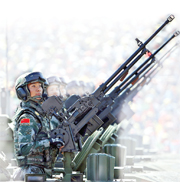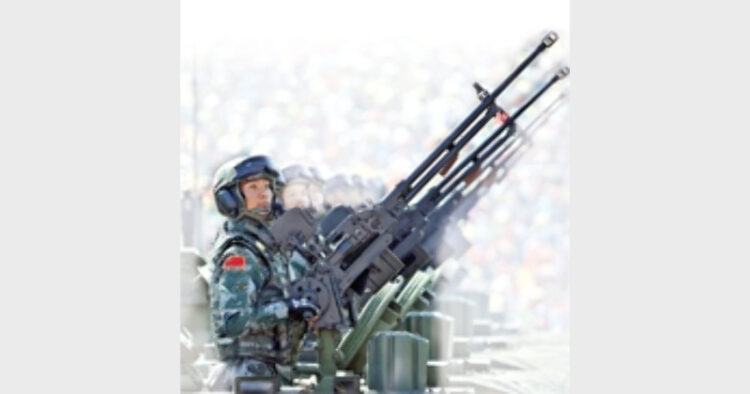 China’s 2016 budget on defence is in single digit for the first time after 2010. It is almost touching upon 7.6 to 8 per cent of the total and it happened due to slow growth of Chinese economy after almost a decade, moving with the pace of 6.9 per cent. In announcing the approximate rate of increase, Fu Ying, the spokeswoman for the China’s ceremonial legislature, National People’s Congress, told reporters that China needs to consider its defence needs, economic development and the country’s fiscal position in drafting the defence budget. With last year’s budget standing at $144 billion, an increase of 7 to 8 per cent would take defence spending for this year to between $154 and $155 billion – still less than one-third of that of the US. The defence budget increased 10.1 per cent last year, despite falling growth, raising concerns about whether such spending was sustainable.
China’s 2016 budget on defence is in single digit for the first time after 2010. It is almost touching upon 7.6 to 8 per cent of the total and it happened due to slow growth of Chinese economy after almost a decade, moving with the pace of 6.9 per cent. In announcing the approximate rate of increase, Fu Ying, the spokeswoman for the China’s ceremonial legislature, National People’s Congress, told reporters that China needs to consider its defence needs, economic development and the country’s fiscal position in drafting the defence budget. With last year’s budget standing at $144 billion, an increase of 7 to 8 per cent would take defence spending for this year to between $154 and $155 billion – still less than one-third of that of the US. The defence budget increased 10.1 per cent last year, despite falling growth, raising concerns about whether such spending was sustainable.
Last year, the People’s Liberation Army official budget grew to 10 per cent to about $136 billion, and in 2014 it grew 12.2 per cent. From 2005 to 2014, China’s official military budget grew an average of 9.5 per cent annually. It needs to be mentioned that Chinese official budget is not a full story. There are many segments of the defence areas that are not clubbed in this budget. Chinese Premier has categorised this budget as China’s composite posture establishing peace in the region, which does not reflect in the budget. Pentagon and global arms bodies estimate that actual military spending may be anywhere from 40 to 50 per cent more because the official budget does not include the costs of weapons imports, research & development and other progress.
The Chinese Rationale for Defence Budget
In 1997 Chinese military expenditure totalled only about $10 billion roughly on par with Taiwan and significantly less than that of Japan and South Korea. But it picked momentum since 2000. The whopping defence budget of China narrates a different story. Many of the Chinese hawkish were expecting more than 10 per cent of the total budget expenditure this year. The Chinese logic is the same old one.
- China is facing heat from different sources. The South China Sea and East Asia Sea have many disputed areas. Most of the countries located in this area have increased their defence budgetary shares this year. Japan, Vietnam and many South Asian countries have added extra weight on defence share. Russia has done the same. The US defence budget is much larger than China.
- China has been in the last few years converted to be arms supplier of many countries. During the Cold War, one of the revenues were augured by the Super Powers through exporting the arms supplies to the troubled areas of the world. China is following the same route and expanding its tentacles in the Sub Saharan Africa to South Asia which needs extra money to invest on defence.
- Being a declared economic power of the world, outpacing America, China still lags behind America in terms of military might. The quality of weapons and modernisation of its armoury need extra amount to match with the US. It is a continuous process and long drawn venture. That is how China is pursuing relentlessly double digit defence budget.
- A robust armed forces remains a major priority for China, who has pushed an increasingly aggressive campaign to assert territorial claims in the South China Sea and East China Sea.
- China’s new mission including UN Peacekeeping operation, are now taking China’s military much further, possibly even overseas, on anti-terrorism missions as mandated by new law. Meanwhile, China’s Asia-Pacific neighbours are responding with their own increased military spending. Japan has already passed a record high defence budget for 2016. China’s new budget for the Peoples’ Liberation Army is more than three times than those of other big spenders such as France, Japan and the United Kingdom and nearly four times than that of its rising Asian rival Bharat.
- Beijing is also feeling public pressure to show it can protect its claims to the South China Sea after United States began conducting “freedom of navigation” operations near islands where China has been carrying out controversial works and station weapons.
China’s Defence Budget and its Impact on Bharat
China has complex boundary disputes with Bharat. About 4,057 KM line of Actual Control (LAC) is undefined. LAC is divided into three sectors, Western Sector comprises Ladakh, Middle Sector is boundary along Uttrakhand and Eastern Sector is Sikkim and Arunachal Pradesh (AP). Aksai Chin, is one of the main contested areas which is under illegally occupation of China. The other contested area is AP which is part of Bharat. China claims it to be part of Tibet.
Chinese defence budget over the past several decades significantly increased which is now more than three times than that of Bharat. China has been exporting arms to Pakistan and other South Asian countries. The installations of its nuclear missiles in Tibetan Plateau are known to the world. The road constructions in the Himalayan terrain facilitate Chinese PLA to maneuver in the Bharateeya security areas. That is how defence budget of China becomes a concern for Bharat. The allocation for defence budget in the current fiscal year of Bharat is 2.2 trillion ($ 35 billion). The core message of Finance Minister Arun Jaitley was the push to become less dependent on foreign military know-how and imports and to revive the Bharateeya defence industry.
The Modi government which made military modernisation one of its top priorities, has increased the stakes that foreign defence contractors were allowed to hold defence ventures from 26 per cent to 49 per cent.
There has been budgetary constraints in Bharat’s Defence preparedness. Three-fourth of the total allotted budget is spent on maintaining the world’s third largest standing force. This clearly implies that only a few new weapons will be ordered this year. China does not include expenditures on arms imports in their military expenditures. China has a sizeable indigenous defence industry which Bharat lacks.
China started a massive military and infrastructure build up along the Bharateeya border years ago. Bharat is only trying to play catch up. The plan which is still awaiting government nod comprises of two aspects. A new mountain corps foe deployment along the China border which will cost the nation $ 11.5 billion at the current price level. Creation of three more brigades at the cost of 3.5 billion. The Bharateeya government is likely to approve the plan but budget constraints are coming on the way. China’s defence spending is by no means transparent. China’s published defence budget does not include large categories of expenditure, including expenses for strategic forces, foreign acquisitions, military-related research and development, and China”s paramilitary forces.
Nevertheless, China’s Defence budgetary allocation impinges on Bharateeya security. China is adjacent to our border that is with the tag of a super power. This tag is problem for Bharat.
Dr Satish Kumar (The writer is Head CIR, CUJ Ranchi)













Comments